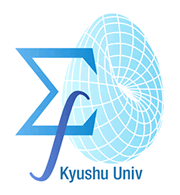Analysis Seminar in Kyushu University
Seminars in 2018
August 20, 2018 (Mon.)
- Date
- August 20, 2018 (Mon.) 13:20--17:30
- Venue
- Kyushu University, Ito Campus, West Zone 1, Room D-625
- Speakers
-
Yachun Li (Shanghai Jiao Tong University)
Myoungjean Bae (Pohang University of Science and Technology)
Chunjing Xie (Shanghai Jiao Tong University)
Jan Brezina (Tokyo Institute of Technology) - Titles
-
13:20--14:10 Yachun Li (Shanghai Jiao Tong University) Qualitative Studies on Radiation Hydrodynamics Equations 14:25--15:15 Myoungjean Bae (Pohang University of Science and Technology) Global existence of weak shocks past solid ramps 15:30--16:20 Chunjing Xie (Shanghai Jiao Tong University) Some studies on steady flows in channels 16:40--17:30 Jan Brezina (Tokyo Institute of Technology) Measure-valued solutions and Navier-Stokes-Fourier system - Abstract 1 (Yachun Li)
- In this talk I will present recent progress on viscous or inviscid radiation hydrodynamics equations for compressible fluids. The results include the local existence of classical solutions with vacuum, some blow-up results of classical solutions, and some regularity criteria.
- Abstract 2 (Myoungjean Bae)
- When a steady supersonic flow impinges onto a solid wedge whose angle is less than a critical angle, so called detachment angle, there are two possible configurations: the weak shock solution and the strong shock solution. It is widely conjectured that the weak shock solution is physically admissible since it is the one observed experimentally. This is called ‘Prandtl’s conjecture’. In this talk, I address this longstanding open conjecture, and present recent analysis to establish the stability theorem for steady weak shock solutions as the long-time asymptotics of unsteady flows for all the physical parameters up to the detachment angle for potential flow. This talk is based on joint work with Gui-Qiang G. Chen (Univ. of Oxford) and Mikhail Feldman (UW-Madison).
- Abstract 3 (Chunjing Xie)
- In this talk, both the inviscid and viscous flows in channels will be investigated. We will first address the well-posedness for steady inviscid compressible flows in nozzles with emphasis on the fine properties of subsonic flows in nozzles. Then we study the stability of some special viscous flows in channels with the aid of some weighted energy estimate.
- Abstract 4 (Jan Brezina)
- Encouraged by the ideas and results obtained when studying measure-valued solutions for the Complete Euler system we introduce measure-valued solutions to the Navier-Stokes-Fourier system and show weak-strong uniqueness. Namely, we identify a large class of objects that we call dissipative measure-valued (DMV) solutions, in which the strong solutions are stable. That is, a (DMV) solution coincides with the strong solution emanating from the same initial data as long as the latter exists.
August 2, 2018 (Thur.)
- Date
- August 2, 2018 (Thursday) 13:00 -- 16:50
- Venue
- Kyushu University, Ito Campus, West Zone 1, Room D-625
- Speakers
-
Bongsuk Kwon (Ulsan National Institute of Science and Technology)
Chun-Hsiung Hsia (National Taiwan University)
Ryo Takada (Kyushu University) - Titles
-
13:00 -- 14:00 Bongsuk Kwon Small Debye length limit for the Euler-Poisson system 14:20 -- 15:20 Chun-Hsiung Hsia On the mathematical analysis of synchronizations 15:50 -- 16:50 Ryo Takada Strongly stratified limit for the 3D inviscid Boussinesq equations - Abstract 1 (Bongsuk Kwon)
- We discuss existence, time-asymptotic behavior, and quasi-neutral limit for the Euler-Poisson equations. Specifically we construct the global-in-time solution of the plasma sheath in the regime of Bohm's criterion, and investigate the properties of the solution including the time-asymptotic behavior and small Debye length limit. If time permits, some key features of the proof and related problems will be discussed. This is joint work with C.-Y. Jung (UNIST) and M. Suzuki (Nagoya Inst. Tech.).
- Abstract 2 (Chun-Hsiung Hsia)
- The phenomena of synchronization can be easily found in a variety of natural systems. The first reported observation of synchronization is one Dutch scientist’s discovery: Christiaan Huygens realized that two pendulum clocks hanging on the wall have always ended up swinging in exactly the opposite direction from each other in 1665. Since then, people have recognized synchronization phenomena in various areas including circadian rhythms, electrical generators, Josephson junction arrays, intestinal muscles, menstrual cycles, and fire flies. Although it is studied in many different scientific disciplines such as applied mathematics, biology and nonlinear dynamics, the underlying mechanism of synchronization has remained a mystery. Among a number of mathematical models, the differential equations proposed by Kuramoto and Winfree have received considerable attention. In this lecture, we shall present a mathematical analysis for the Kuramoto model. In particular, we shall focus on the time-delayed effect.
- Abstract 3 (Ryo Takada)
- In this talk, we consider the initial value problem of the 3D inviscid Boussinesq equations for stably stratified fluids. We prove the long time existence of classical solutions for large initial data when the buoyancy frequency is sufficiently high. Furthermore, we consider the singular limit of the strong stratification, and show that the long time classical solution converges to that of 2D incompressible Euler equations in some space-time Strichartz norms.
June 11, 2018 (Mon.)
- Date
- June 11 (2018) 16:00 -- 17:00
- Venue
- Kyushu University, Ito Campus, West Zone 1, Room D-625
- Speaker
- Shih-Hsien Yu (National University of Singapore)
- Title
- Wave motions around a 2-D viscous Burgers’ shock profile
- Abstract
- In this talk we introduce the Laplace wave trains to form a basis for the 2-D wave scattering around the 2-D inviscid Burgers’ shock wave for the viscous Burgers’ profile for a 2-D Burgers’ equation. With all those wave trains around the inviscid shock wave, one can construct the wave trains for the problem linearized around the viscous shock profile. After the complete structure of the wave scattering in terms of the Laplace wave train, one can invert the wave train information into a pointwise space-time structure of the Green’s function for the problem linearized around the Burgers’ shock profile. With the pointwise structure of the Green’s function, the nonlinear wave scattering follows.
